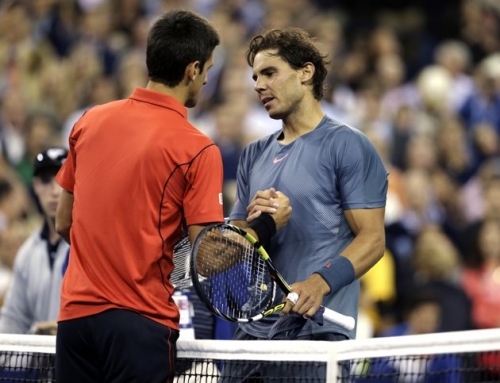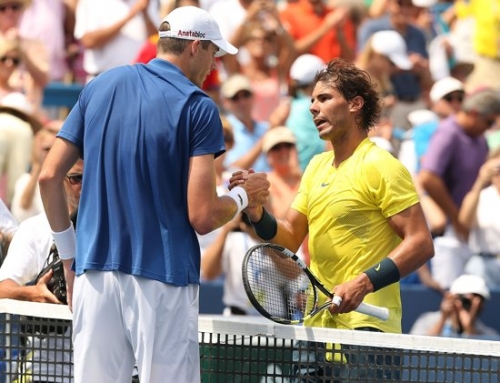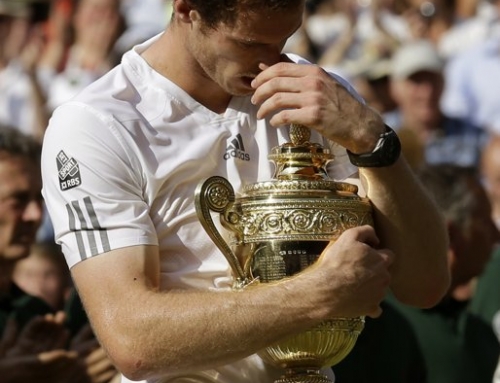 For a long time, Roger Federer struggled against two players: David Nalbandian and Lleyton Hewitt. Some say that it was Rafael Nadal that pushed Federer to be better, but it was originally Nalbandian and Hewitt that originally pushed Federer. In the old days, Federer wasn’t the baseliner he is today. He altered his game so he could become a better baseliner, abandoning the serve and volley style he originally used.
For a long time, Roger Federer struggled against two players: David Nalbandian and Lleyton Hewitt. Some say that it was Rafael Nadal that pushed Federer to be better, but it was originally Nalbandian and Hewitt that originally pushed Federer. In the old days, Federer wasn’t the baseliner he is today. He altered his game so he could become a better baseliner, abandoning the serve and volley style he originally used.
Many people say what a genius Roger Federer is. How he moves so effortlessly, how his forehand looks like a liquid whip. The genius is how Federer managed to transform himself, a player that once let anger and impatience lead to losses, that let his emotion burden him more than it should have. One only has to look at Marat Safin to see someone so talented that didn’t surround himself with the right people, that didn’t reign in his emotions, that didn’t focus himself. Federer has managed to get rid of anger in his game, get people around him to get him well trained, well balanced, to alter his game to deal with modern players.
Ivan Lendl didn’t invent the inside-out forehand. But he may have been the first to realize that the forehand was more powerful than the backhand and if you were quick enough, you could leave space opened on the right side of the court, but hitting a powerful shot that robbed your opponent of time was worth the risk of bad court positioning.
Roger Federer certainly didn’t invent the inside-out forehand, but he pushed this idea of hitting everything with your forehand to its limits. He knew his backhand was a limitation. There’s no doubt Federer his a very sweet one-handed backhand, but he’s doesn’t generate a lot of winners on that end. If the post-Lendl era of tennis taught modern pros anything, it was the forehand was a much bigger weapon than the backhand. Jimmy Connors may go down as the last player whose backhand was a superior shot in every way to his forehand, a shot he couldn’t come over easily.
Although Roger Federer probably didn’t invent the inside-in forehand, he certainly used this shot frequently. If hitting an inside-out forehand leaves a lot of space open in the deuce court, there is some solace that a well hit inside out forehand puts pressure on an opponent, typically on their backhand, and hitting that shot up the line is a high risk shot. The inside-in shot, by contrast, typically leaves not only the right side of the court empty, but it also puts the shot to an opposing player’s forehand, and lets them hit that shot crosscourt to that empty spot.
And yet, Federer’s genius is realizing that if you learn to hit that shot hard and deep and consistent, then it’s tough for even top players to angle it to the open court. Indeed, the inside-in shot is needed as a counter-threat to the inside-out shot. If Federer’s opponents began to anticipate the inside-out shot, they might power it up the line for a winner. Federer therefore needs the the threat of the inside-in forehand to prevent players from cheating too far to one side or the other.
Here’s the problem. Roger is not 21 anymore. He’s not even 25. As he nears 30 years of age, Roger must realize that running around his backhand requires superior mobility. If anything, del Potro’s win over Federer at the US Open must demonstrate to Federer that leaving court space open gives a player like del Potro an invitation to hit that huge forehand. And although Federer has learned to hit a very good squash shot forehand for just such an emergency, hitting it time and again means a defensive shot.
Roger constructed this strategy to overcome a weakness and to highlight his strength. However, Roger seems to have rethought how he should play toward the latter parts of his career.
Each winter, Roger Federer, like most savvy players, spends time working on his game. Most players work on fitness, and either work on a weakness or improve a strength. In 2008, Roger said he was working on his serve and his volley. When critics claimed his forehand was an issue, Roger went back to work on a strength.
This past winter, Roger seems to have spent a great deal of time on his backhand. There are several aspects to this. First, he’s worked on his slice. Indeed, during much of the finals, Roger sliced back nearly every return from his backhand. This was likely a safer return for Federer, but since he sliced it up the middle, Murray was left without many angles to work with.
Second, he’s increased the power off his backhand as well as his steadiness. Roger needs to be able to use the backhand merely to rally. It shouldn’t be so slow that players attack his backhand (which Murray tried to do at the beginning of the first set). Roger has worked on his backhand so he can hit a sharp angle, almost a passing shot with the other player at the baseline. Finally, to supplement that, Roger needed to get his down-the-line backhand back in shape. If he only hits good crosscourt backhands, players will adjust by cheating more in that direction.
The best two-handers in the world, players like Djokovic, Davydenko, Murray, Nadal, all hit a very good down-the-line backhand. If the crosscourt backhand is the bread and butter, you need a reliable down-the-line shot to keep the other player honest. It seems Roger Federer doesn’t just learn to hit a shot, but sees it as a group of shots. Thus, it’s not a topspin backhand, but it’s the crosscourt backhand, the down the line backhand, and the slice. If Federer can hit a reasonable number of winners on his backhand, then he doesn’t need to run around his backhand nearly as much, and can choose more opportune times to do it.
Federer appears to have made a small addition to his forehand as well. Roger was shanking his forehand a bit the last two years. He seems to have added a loopier forehand with less pace, but more spin. You saw this shot mostly in his first round match. He was back to hitting his normal forehand by the later rounds. It may be that Federer developed this shot so he could get into rhythm first.
Will these changes pay off? It’s certainly started off well, with Federer winning the Australian Open. And it means that the best player in tennis still has more tricks up his sleeve.




![[US Open Men’s Final] Can Djokovic beat Nadal in the finals?](https://www.essentialtennis.com/wp-content/uploads/2013/09/20130909djokovic-500x383.jpg)


![[French Open] The tactics of the Djokovic-Nadal semifinals](https://www.essentialtennis.com/wp-content/uploads/2013/06/20130607nole-500x383.jpg)